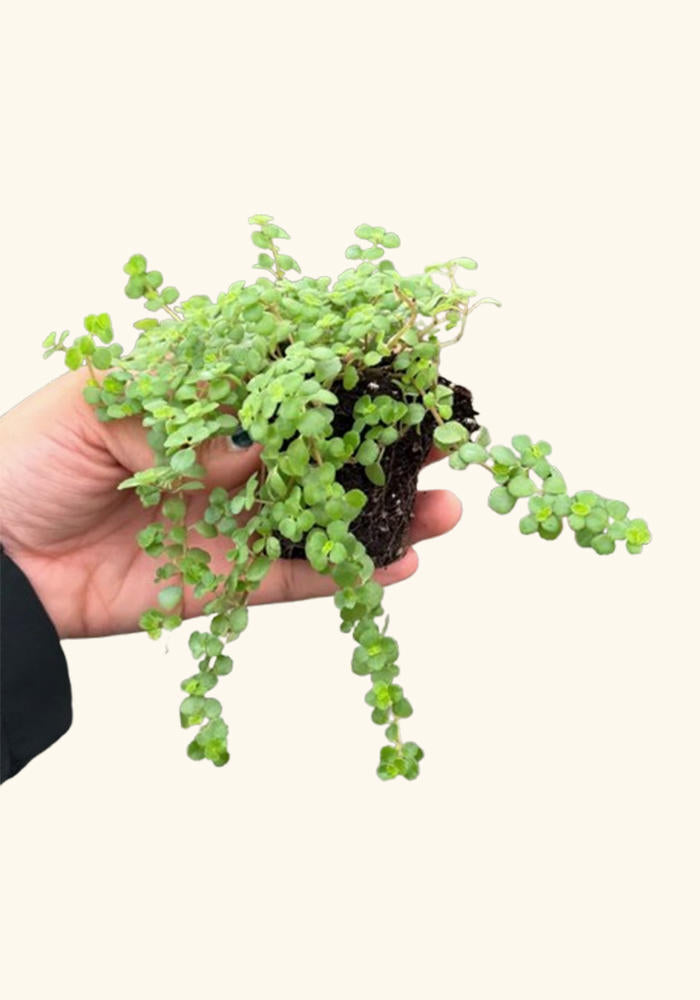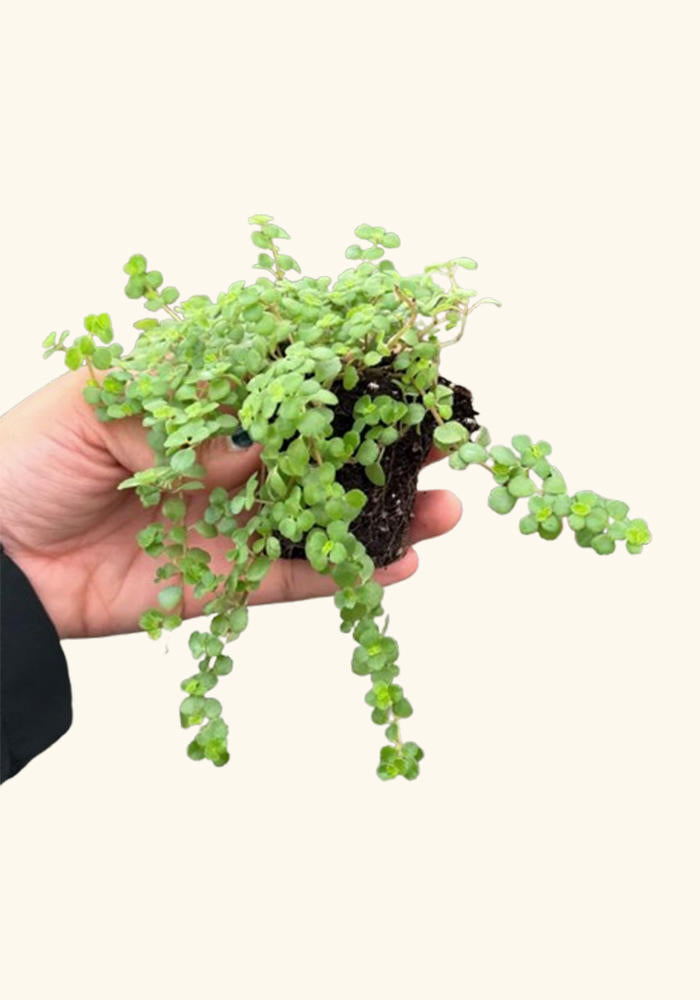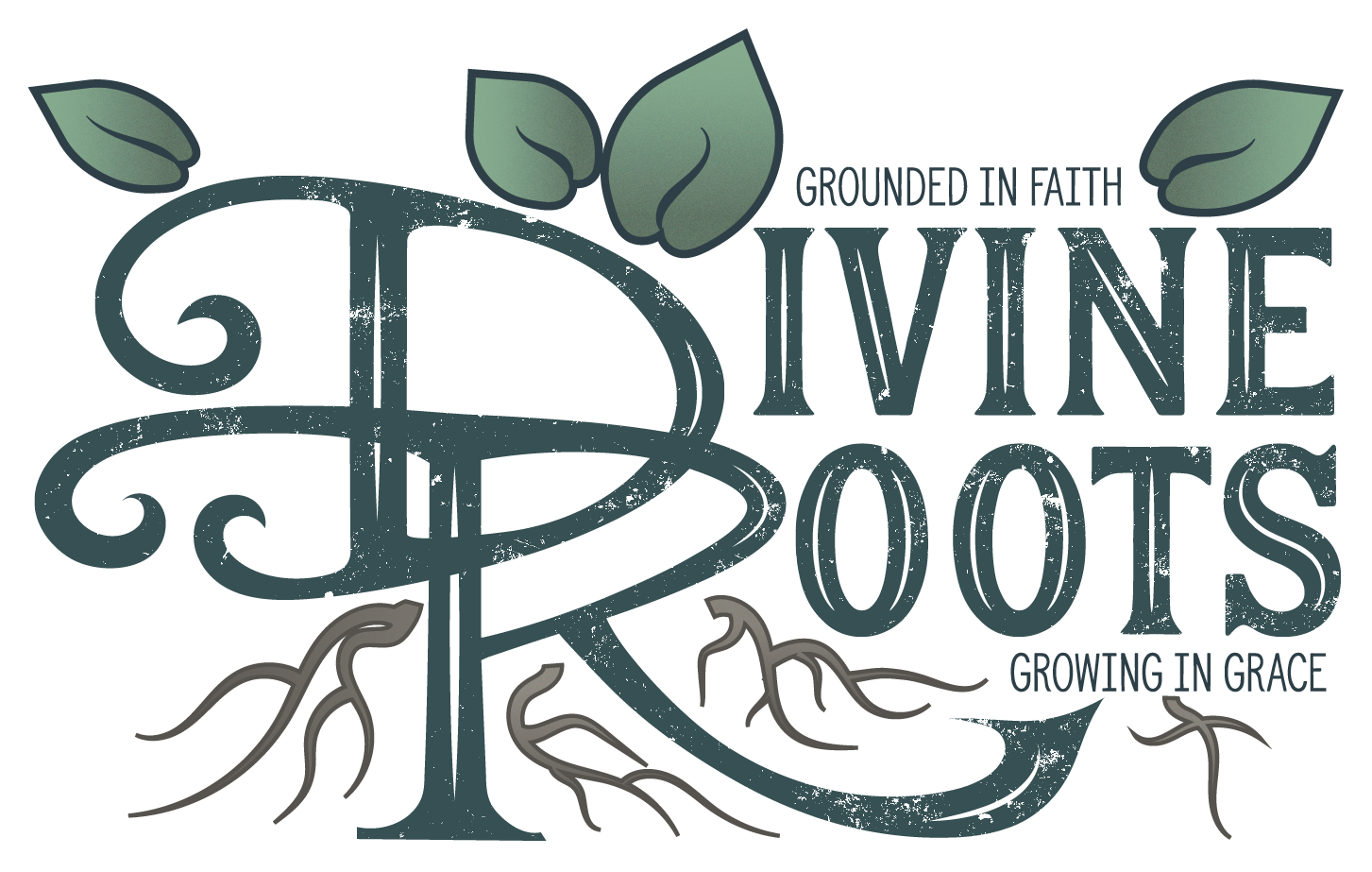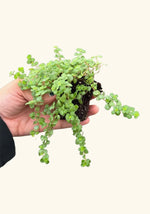
Pilea Tiny Tears Rooted Starter Plant
Estimated delivery between 01 November and 03 November.
At Divine Root, we are committed to delivering healthy, high-quality indoor plants to our customers. While we do not accept returns due to the perishable nature of live plants, we offer a 30-day plant health guarantee and store credit for qualifying issues. Please read our Refund Policy carefully to understand how we handle concerns regarding plant health, shipping, and order

Pilea Tiny Tears Care Guide & Presentation
Pet Safe
Yes
Water Needs
Medium
Sunlight
Bright
Hardiness Zones
10-12
Temperature
60°F to 75°F
Suitable Space
Terrariums & Fairy Gardens
Humidity
Medium
Plant Class
Pilea
Plant Type
Perennial
Plant Characteristics
Tiny, Lush Green Leaves
Genus
Pilea
Fertilizing
Monthly
Re-potting
1-2 Years
Cleaning
As needed
Propagation
Offsets
Pilea Tiny Tears Rooted Starter Plant: Overview
The Pilea Tiny Tears (Pilea depressa) is a charming, low-growing plant with delicate, round, deep green leaves that are a perfect addition to any home. Known for its cascading, trailing growth habit, this delightful plant forms a lush, dense mat of foliage that will add a refreshing touch to your indoor garden. The Pilea Tiny Tears is part of the Urticaceae family and hails from the tropical regions of Central and South America, where it thrives in the forest floor's shady, humid environment. As an easy-care, adaptable houseplant, it makes a fantastic choice for both beginners and seasoned plant lovers alike.
This beauty is perfect for hanging baskets, planters, or as a trailing accent on shelves and windowsills. It enjoys bright, indirect light and doesn't require much attention to thrive. The Pilea Tiny Tears is also a non-toxic plant, making it a safe addition for households with pets.
Pilea Tiny Tears: Benefits
- Low-maintenance houseplant
- Pet-safe and non-toxic
- Unique trailing growth habit
- Great air-purifying properties
- Ideal for small spaces or hanging baskets
Pilea Tiny Tears: Alternative Names
- Creeping Pilea
- Trailing Pilea
- Baby Tears Pilea
Pilea Tiny Tears Care Guide
The Pilea Tiny Tears is a low-maintenance plant that thrives with minimal attention. Here are a few tips to keep it healthy and thriving:
Watering
This plant prefers to be kept slightly moist but should not be overwatered. Allow the top inch of soil to dry out between waterings. Be sure to use a pot with proper drainage to prevent water from accumulating at the bottom. Water thoroughly, but make sure excess water drains away to avoid root rot.
Light and Temperature
The Pilea Tiny Tears enjoys bright, indirect light but can tolerate lower light conditions. However, to maintain its lush appearance, a spot near a window with filtered light is ideal. It thrives in temperatures ranging from 60°F to 80°F, so keep it away from cold drafts or extreme heat sources.
Humidity
Being a tropical plant, the Pilea Tiny Tears enjoys higher humidity levels. If your home is dry, consider placing the plant on a pebble tray with water, or mist the leaves occasionally to provide the moisture it needs.
Soil, Repotting, and Fertilizing
The Pilea Tiny Tears prefers well-draining potting soil. A mix that contains peat moss, perlite, and a bit of sand works well. When repotting, choose a pot that is 1-2 inches larger in diameter than its current pot. Fertilize the plant monthly during the growing season (spring and summer) with a balanced, water-soluble fertilizer diluted to half strength. Avoid fertilizing in the winter when the plant's growth slows down.
Propagation
Pilea Tiny Tears can be easily propagated by cutting a healthy stem with a few leaves attached. Place the cutting in water or directly into a well-draining soil mix to root. It's an ideal plant for sharing with friends or expanding your collection!
Pruning, Cleaning, and Common Issues:
The plant’s trailing vines can be trimmed back to maintain a tidy appearance. Trim away any leggy or dead growth to promote bushier new growth. Keep an eye out for pests like aphids or spider mites, which can occasionally affect indoor plants. Regularly clean the leaves with a damp cloth to remove dust and encourage healthy growth.
Pilea Tiny Tears: Placement, Companion & Alternative Plants
Best Locations & Uses:
- Ideal for hanging baskets, shelves, or as a trailing plant
- Great for homes, apartments, or offices with bright, indirect light
- Perfect for plant lovers with limited space, as it grows well in small pots
- Pet-friendly and low-maintenance, perfect for households with cats or dogs
- Makes an excellent addition to plant collections or as a thoughtful gift for plant enthusiasts
Companion Plants:
Pair your Pilea Tiny Tears with other plants that enjoy similar growing conditions for a stunning plant display:
- Pothos (Epipremnum aureum): A versatile, trailing plant that can complement the Pilea’s trailing growth.
- Spider Plant (Chlorophytum comosum): Another easy-to-care-for, pet-safe plant with similar light and water needs.
- Philodendron: Their heart-shaped leaves and trailing growth make them an excellent match for the Pilea.
Alternative Plants:
If the Pilea Tiny Tears isn’t quite the right fit for you, here are some alternative plants that also offer beautiful trailing vines and ease of care:
- String of Pearls (Senecio rowleyanus): Known for its unique, bead-like leaves, this trailing plant thrives in similar conditions.
- English Ivy (Hedera helix): A classic, trailing plant with a little more vigor, perfect for hanging baskets or as ground cover.
- Creeping Jenny (Lysimachia nummularia): A fast-growing ground cover with bright green, round leaves, offering a fresh, vibrant look.
Add a Pilea Tiny Tears to Your Home!
Bring the beauty and charm of the Pilea Tiny Tears into your indoor garden and enjoy its easy-care nature, lush green foliage, and delightful cascading growth. Whether you're a seasoned plant lover or new to indoor gardening, this plant will quickly become a favorite in your collection!


